NIR light therapy can boost your memory by stimulating your brain cells' natural healing and regeneration processes. You'll benefit from increased ATP production, enhanced blood flow, and higher BDNF levels – all critical factors for memory improvement. The therapy works by using specific wavelengths (810-1064nm) that penetrate your skull to activate cellular repair and create new neural connections. You can access this treatment through LED panels, specialized helmets, or intranasal devices, with sessions typically lasting 5-20 minutes. While memory enhancement is a key benefit, NIR therapy's full spectrum of cognitive advantages offers even more promising possibilities for your brain health.
Understanding NIR Light Brain Therapy
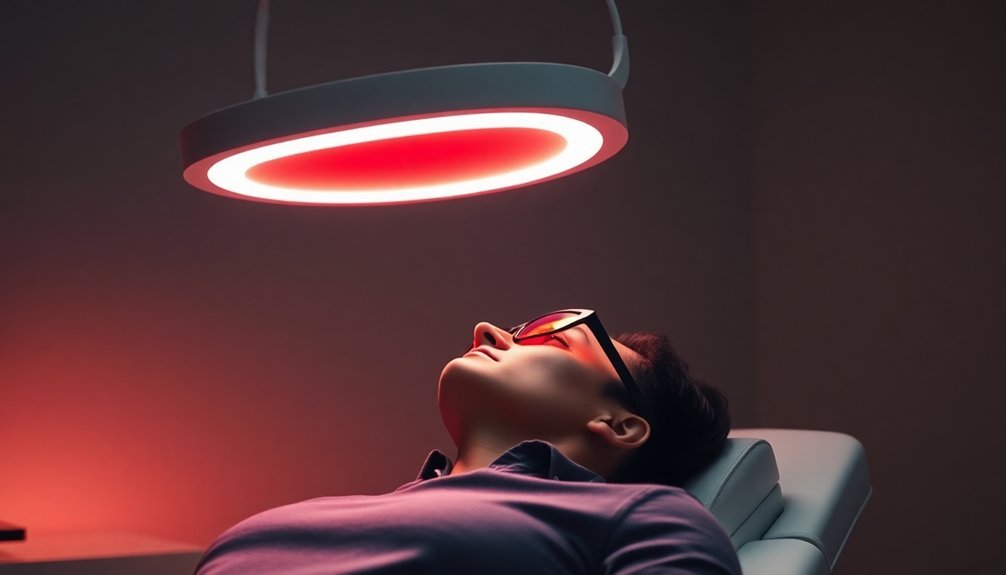
How does shining light on your brain actually boost its performance? Near-infrared (NIR) light therapy works by penetrating your scalp and skull to reach brain cells directly. When NIR light hits your brain tissue, it activates the mitochondria – your cells' power plants – increasing their production of ATP, the energy currency of cells.
You'll find that NIR therapy isn't just about energy production. The treatment triggers the release of nitric oxide, which improves blood flow to your brain, delivering essential oxygen and nutrients to brain cells. Regular sessions can enhance BDNF levels, promoting better neural function and the growth of new brain cells.
It's also effective at reducing inflammation, a common factor in many neurological conditions. What's particularly exciting is how NIR therapy enhances neuroplasticity, making your brain more adaptable to change and learning.
The process is completely non-invasive, typically delivered through LED panels or specialized helmets that emit specific wavelengths of near-infrared light. The technology targets cytochrome C oxidase in your brain cells' mitochondria, kickstarting a cascade of beneficial cellular responses.
Research shows that this approach can improve your cognitive function, memory, and overall brain health, making it a promising treatment for various neurological conditions.
Memory Improvement Research Results
Research into NIR light therapy reveals compelling evidence for memory enhancement across multiple clinical trials. You'll find that studies consistently show significant improvements in memory retention, processing speed, and overall cognitive function among participants receiving NIR treatment.
The results demonstrate how this non-invasive therapy enhances your brain's mitochondrial efficiency, leading to better neural performance and cell survival. In a recent pilot study, participants receiving just six minutes of treatment twice daily showed remarkable cognitive improvements over four weeks.
When you undergo NIR light therapy, you're benefiting from increased blood flow to your brain, which delivers essential nutrients and oxygen to your neurons. Clinical trials have documented that this boost in circulation correlates directly with improved memory function and learning capabilities.
The therapy's ability to reduce oxidative stress and promote neurogenesis means you're not just treating symptoms – you're actually supporting your brain's natural healing processes.
You'll see the best results with consistent treatment sessions, as studies show the benefits are cumulative and long-lasting. The research particularly highlights improvements in both short-term and long-term memory formation, with participants maintaining these cognitive gains well after their treatment periods.
When combined with healthy lifestyle choices, NIR therapy offers a promising approach to enhancing your memory function.
Brain Health Benefits
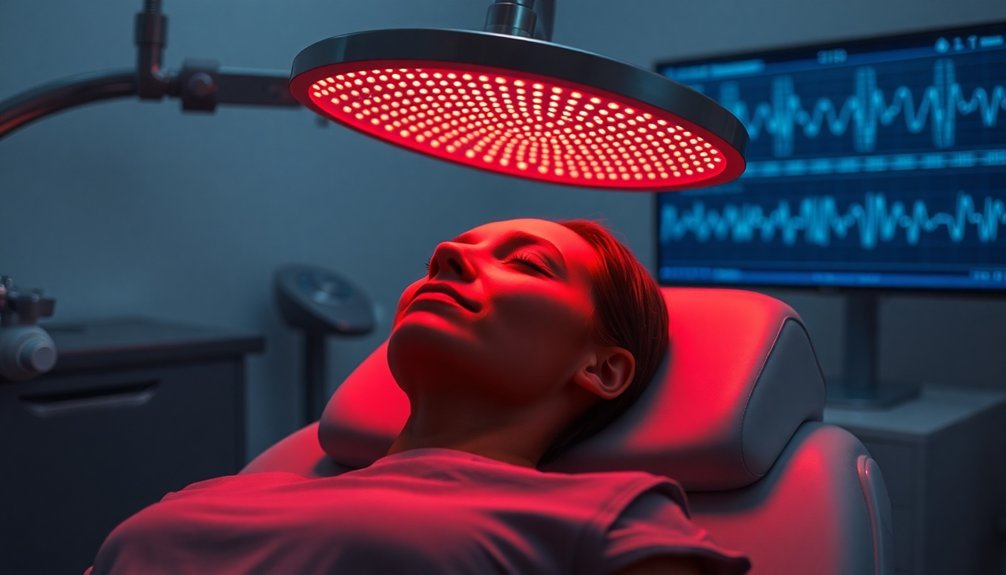
Near-infrared light therapy offers extensive brain health advantages that extend far beyond memory enhancement. When you undergo NIR therapy, you'll experience improved blood flow to your brain, which means better oxygen and nutrient delivery to your neural cells.
This therapy stimulates your brain's mitochondrial activity, leading to increased energy production that keeps your neurons functioning at their best. The gentle, non-invasive treatment can be safely administered through specialized devices for optimal results.
Your brain's protective mechanisms get a significant boost through NIR therapy's neuroprotective effects. It helps reduce inflammation and oxidative stress while promoting the growth of new brain cells.
You'll benefit from enhanced brain connectivity and better overall cognitive function, which is particularly valuable if you're dealing with neurological conditions or age-related cognitive decline.
Key brain health benefits you'll receive include:
- Enhanced cognitive abilities, including better focus and problem-solving skills
- Improved neuroplasticity, supporting learning and adaptation
- Reduced inflammation and oxidative damage to brain cells
- Increased cerebral blood flow and tissue oxygenation
Research continues to reveal more benefits of NIR therapy, showing promise in treating various neurological conditions, from ADHD to neurodegenerative disorders. Regular sessions can help protect your brain health while enhancing its performance.
Dementia Treatment Progress
Recent breakthroughs in NIR light therapy have shown promising results for dementia patients, particularly those with Alzheimer's disease. Clinical trials have demonstrated that NIR treatment can improve cognitive function, enhance daily living activities, and boost memory recall. Light-emitting modules can now be precisely positioned to target specific regions of the brain affected by dementia.
Patients who've undergone this therapy also experience better sleep patterns and reduced anxiety symptoms.
The science behind NIR's effectiveness lies in multiple mechanisms. It reduces amyloid-β buildup, stimulates stem cell production for new neuron formation, and activates BDNF to promote synaptic growth. You'll benefit from its ability to support your brain's glymphatic system, which aids in detoxification and neuroprotection, while simultaneously reducing inflammation associated with neurodegenerative conditions.
When combined with other emerging technologies like 40Hz flashing light therapy and temporal interference stimulation, you're looking at a thorough approach to brain health. These non-invasive treatments work together to enhance gamma wave rhythms and target deep brain structures without surgery.
While larger clinical trials are still ongoing, you can expect to see more treatment options combining NIR therapy with other brain-training techniques for superior results in dementia care.
Light Wavelengths That Matter
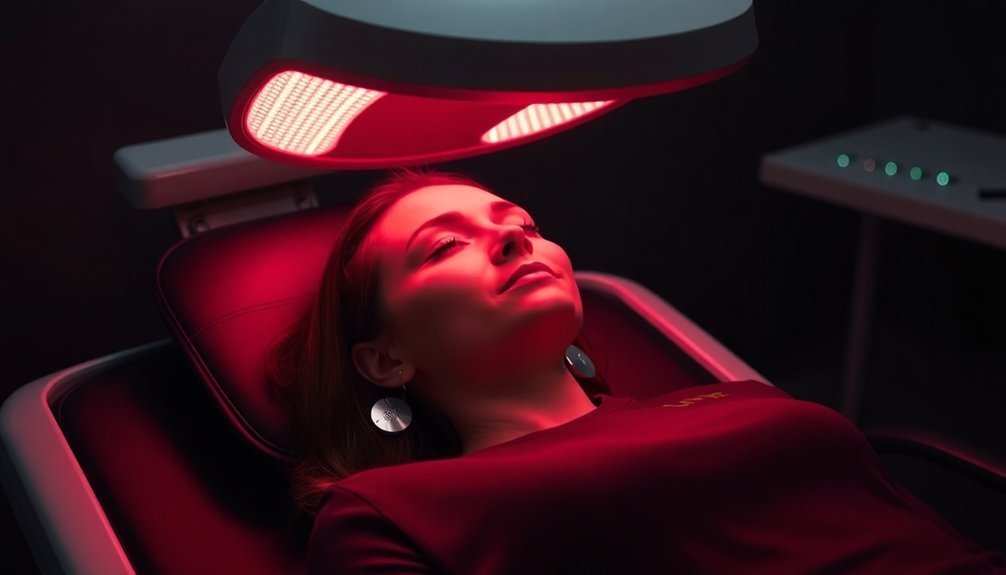
When you're looking to boost memory with NIR brain therapy, you'll want to focus on wavelengths between 810 nm and 1,064 nm, which provide the ideal therapeutic window for brain photobiomodulation.
Your brain responds best to NIR light in this range because it penetrates the skull effectively while maintaining safe power densities between 75 mW/cm^2 and 150 mW/cm^2.
These specific wavelengths trigger beneficial responses in your brain cells by stimulating mitochondrial function and improving cerebral blood flow, making them essential for memory enhancement.
Therapeutic Wavelength Ranges
Understanding the precise wavelengths of near-infrared light proves essential for effective brain therapy outcomes. The ideal range for brain photobiomodulation falls between 810-1064 nanometers, with 810nm being particularly effective for its penetration depth and ability to stimulate mitochondrial responses in your brain cells.
You'll find the most therapeutic benefits within the optical window of 600-1100nm, where NIR light can reach deep brain tissues with minimal interference from blood and water. This specific range allows for maximum penetration while maintaining safety and effectiveness in treating various neurological conditions.
Key benefits you'll get from these therapeutic wavelengths include:
- Enhanced brain energy metabolism through improved ATP production
- Reduced inflammation and increased neuroprotection
- Stimulated neurogenesis and synaptic plasticity
- Improved cognitive function and memory performance
Your brain's response to NIR therapy depends heavily on the power density and wavelength used. When you're receiving treatment, the light energy activates biochemical reactions that trigger both immediate and long-term positive effects.
These carefully selected wavelengths work by stimulating your mitochondria and releasing beneficial compounds like nitric oxide, ultimately supporting your brain's natural healing processes.
Brain Response Zones
Different brain regions respond uniquely to specific light wavelengths, with 660nm and 810nm emerging as the most significant frequencies for therapeutic applications. When you're considering NIR therapy for brain enhancement, understanding these wavelengths' distinct effects can help you maximize your results.
The 810nm wavelength proves superior for brain applications, as it penetrates your skull more effectively than shorter wavelengths. It's particularly effective at boosting ATP production in your neurons and enhancing cerebral blood flow.
While 660nm wavelengths still provide benefits by activating mitochondrial pathways and increasing nitric oxide production, research shows they're less effective than 810nm for brain-specific treatments.
Both wavelengths work through similar mechanisms, targeting your brain's cytochrome c oxidase in mitochondria. This interaction triggers a cascade of beneficial effects: increased reactive oxygen species, enhanced nitric oxide production, and activated transcription factors.
You'll likely experience improved cognitive function, better memory retention, and enhanced brain tissue repair. For the best results, these wavelengths can help treat various conditions, from traumatic brain injury to symptoms of anxiety and depression, while boosting your overall brain function and energy production.
Neural Recovery Mechanisms
When you undergo NIR brain therapy, you're activating powerful cellular regeneration mechanisms that restore depleted brain cells through enhanced mitochondrial energy production.
Your brain's blood flow improves substantially during treatment, delivering essential oxygen and nutrients to areas that need repair and rejuvenation.
NIR therapy also increases your neurotransmitter activity, helping your brain cells communicate more effectively and build stronger neural pathways for better memory formation.
Brain Cell Power Restoration
Restoring brain cell power involves complex molecular mechanisms that work together to heal and regenerate neural tissue. When you undergo NIR brain therapy, you're activating multiple pathways that enhance your brain's natural repair systems.
The therapy triggers cytochrome c oxidase, which absorbs near-infrared energy and kickstarts beneficial biochemical reactions in your neurons.
Your brain cells respond to this treatment by:
- Increasing ATP production in mitochondria, giving neurons more energy
- Stimulating the formation of new blood vessels for better oxygen delivery
- Reducing harmful inflammation that can impair cognitive function
- Activating dormant neural stem cells through SUMOylation processes
You'll experience enhanced cellular recovery as the therapy promotes autophagy through the AMPK pathway, preventing neuronal death and supporting healthy brain function.
The treatment works synergistically with your body's natural regenerative abilities, stimulating growth-associated proteins that aid in neural repair. When combined with low-frequency electrical stimulation, NIR therapy can activate genetic neuroplasticity programs, leading to improved neuronal connectivity and enhanced memory function.
This thorough approach to brain cell power restoration helps revive once-dormant neural circuits and supports sustained cognitive improvement.
Blood Flow Enhancement Features
Near-infrared light therapy dramatically enhances your brain's blood flow through precise wavelength targeting and frequency modulation. When NIR light reaches your brain tissue at specific wavelengths, particularly 810 nm, it triggers a vital process called vasodilation.
Your red blood cells and brain cell mitochondria release nitric oxide, causing blood vessels to expand and increase circulation.
This enhanced blood flow delivers more oxygen and nutrients to your brain tissues, which is essential for recovery and top cognitive function. Research using SPECT technology has shown significant increases in regional cerebral blood flow across 138 brain regions, with positive results observed in most study participants.
You'll benefit from carefully calibrated frequencies (73 Hz, 587 Hz, and 1175 Hz) that maximize the therapy's effectiveness. The NIR light penetrates your brain tissue at varying depths, depending on the wavelength, coherence, and power settings.
This non-invasive approach has proven particularly effective for people with traumatic brain injury and other neurological conditions, leading to reduced symptoms and improved cognitive outcomes. Through these blood flow enhancements, you're giving your brain the essential resources it needs for recovery and peak performance.
Neurotransmitter Activity Boost
Your brain kicks into high gear with NIR light therapy's powerful effects on neurotransmitter activity. When NIR light penetrates your brain tissue, it triggers a cascade of cellular processes that enhance the way your neurons communicate.
The increased ATP production directly powers your synaptic connections, making neurotransmitter release more efficient and reliable.
The therapy's impact on your brain's communication system is thorough, targeting multiple aspects of neural function:
- Boosts production of brain-derived neurotrophic factor (BDNF), supporting new neural connections
- Activates early response genes like cfos and cjun to accelerate neural repair
- Promotes the formation of new synapses through enhanced ATP availability
- Strengthens existing neural pathways through improved connectivity
You'll benefit from NIR light's ability to stimulate neurogenesis – the creation of new brain cells – which is vital for memory formation and cognitive function. This process works alongside enhanced synaptogenesis, creating a more robust neural network.
The therapy's ability to trigger anti-inflammatory responses also protects your neurons, ensuring they function at their best for improved memory and cognitive performance. Through these mechanisms, NIR light therapy creates an environment that supports stronger, more efficient neural communication.
Treatment Duration Guidelines
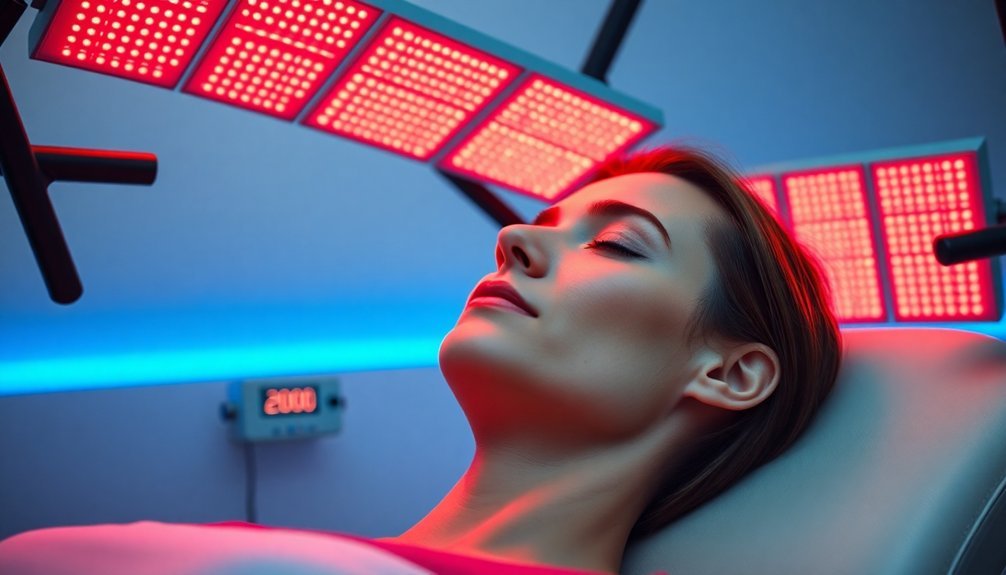
Time is crucial when scheduling NIR brain therapy sessions, with recommended durations typically ranging from 5 to 20 minutes per session.
You'll find that some treatment protocols suggest two 20-30 minute sessions daily for best results, though you should carefully plan extended durations with your healthcare provider.
Research supports various treatment timeframes, including the Birmingham study's approach of using daily two-minute bursts for three consecutive days post-injury, which demonstrated significant improvements in recovery.
If you're following a clinical treatment plan, you might encounter 12-week programs with specifically timed sessions.
When you're planning your NIR therapy schedule, consider that effectiveness isn't just about session length. You'll need to pair appropriate duration with the right wavelength – typically between 633-1065nm – for best results.
For instance, if you're using 810nm wavelength, which has shown superior results in certain applications, you'll want to follow the prescribed duration carefully.
Remember that while longer sessions of 20-30 minutes might be suitable for some conditions, they're not always necessary or beneficial for others.
Always consult your healthcare provider to determine the most appropriate duration for your specific needs.
At-Home NIR Therapy Options
Several effective at-home NIR therapy devices now offer convenient alternatives to clinical treatments, ranging from handheld units to full-body panels. You'll find options like the Pro, which delivers both red (630-660nm) and near-infrared light (800-880nm), or specialized devices like the Neuronic Neuradiant 1070 Helmet with its 256 LED lights for targeted therapy.
When selecting your at-home device, you'll want to think about these key features:
- Medical-grade combinations of red and near-infrared wavelengths for maximum effectiveness
- Built-in safety features, including protective eyewear
- Preset programs for specific needs like relaxation or focus
- Portability and ease of use for consistent treatment
You can integrate these devices into your daily routine while maintaining regular activities. They're designed for safe, long-term use and can complement other treatments you might be receiving.
The devices work by penetrating your scalp and skull to boost cellular energy production, reduce inflammation, and promote brain cell growth. Whether you're addressing memory issues, ADHD, or seeking general cognitive enhancement, at-home NIR therapy provides a practical solution for ongoing treatment and maintenance.
Clinical Study Success Stories
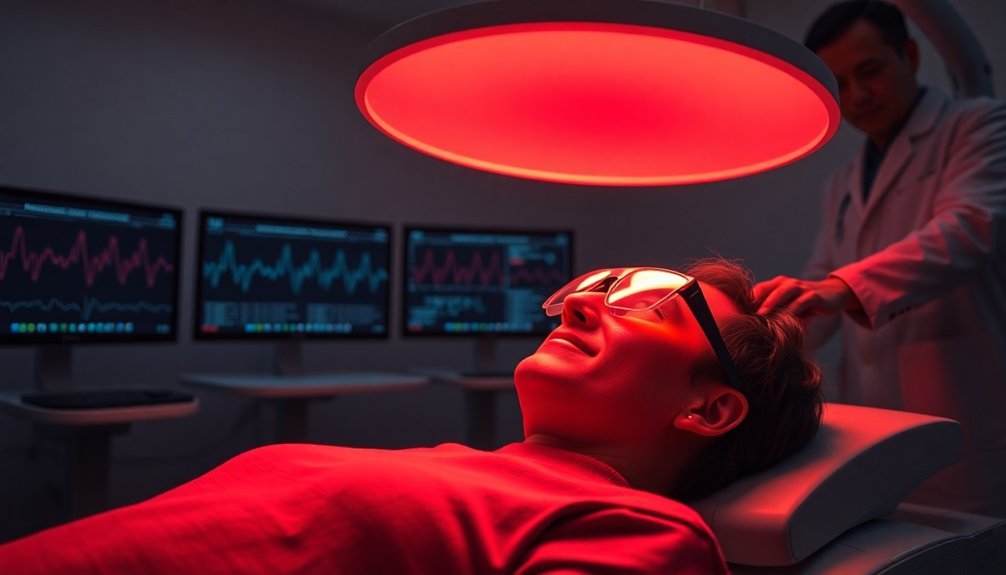
While at-home NIR therapy devices offer convenient solutions, clinical studies have demonstrated remarkable success in memory enhancement across diverse populations.
In a groundbreaking pilot trial, participants aged 45 and above who used an LED helmet for just 6 minutes twice daily showed significant improvements in memory, motor function, and reaction times over four weeks.
You'll find particularly encouraging results in studies involving different age groups. Children with ASD, aged 2-6 years, experienced notable symptom improvements after receiving pulsed NIR light stimulation twice weekly for 8 weeks.
In older adults with mild cognitive impairment, researchers observed measurable memory benefits that persisted for up to a month after treatment.
The science behind these successes is compelling. When targeting specific brain areas like the DLPFC and IPL with different frequencies, you'll see improvements in both early and late word recall.
Studies using AD model mice have revealed that PBM stimulation enhances working memory by regulating neural oscillations, particularly in theta and gamma bands. These findings suggest NIR therapy's potential as a powerful tool for addressing memory-related conditions, from mild cognitive decline to more severe neurological disorders.
Safety And Side Effects
You'll be glad to know that NIR brain therapy has shown zero serious adverse effects across multiple clinical studies, with most participants experiencing only mild sensations like tingling or temporary fatigue.
When receiving NIR treatment, it's crucial to follow safety guidelines, including proper device positioning and recommended session durations set by healthcare professionals.
Regular monitoring during and after sessions helps guarantee long-term safety, while allowing practitioners to adjust treatment parameters if needed.
Safe Application Guidelines
Safety protocols form the foundation of effective NIR brain therapy. When you're starting treatment, it's vital to begin with shorter sessions of 5-10 minutes to assess how your body responds.
You'll need to wear proper eye protection or keep your eyes closed during sessions to prevent strain and headaches.
Before beginning NIR therapy, consult your healthcare provider, especially if you're taking medications that might increase photosensitivity. They'll review your medications and help determine if adjustments are necessary for safe treatment.
Key safety guidelines you should follow:
- Limit sessions to 5-20 minutes to avoid excessive exposure
- Start with shorter durations and gradually increase based on your response
- Maintain consistent power settings as recommended by your provider
- Monitor your skin for any signs of irritation or adverse reactions
Remember that professional oversight guarantees optimal safety and results. If you have existing skin conditions, consulting a dermatologist before starting treatment is essential.
While NIR therapy has shown an excellent safety profile with minimal side effects, following these guidelines will help you maximize benefits while minimizing any potential risks.
Zero Reported Adverse Effects
Clinical research consistently demonstrates the remarkable safety profile of NIR brain therapy, with multiple studies reporting minimal to zero serious adverse effects.
In a thorough study of 31 treated subjects and 18 controls receiving 20-minute NIR sessions, researchers found no adverse events in either group, confirming the therapy's safety at 1 J/cm²·min power density.
While you might experience mild sensations during treatment, they're typically limited to gentle warming, tingling, or minor itching. Some participants report temporary fatigue or light headaches, but these effects are generally mild and short-lived.
You'll find it reassuring that even with long-term exposure, such as twice-daily 6-minute sessions over four weeks, participants showed no adverse effects while experiencing significant improvements in memory and brain processing speed.
When you undergo NIR therapy, you'll receive your first session under clinical supervision to guarantee proper tolerability. Your treatment duration can be adjusted based on your comfort level, typically ranging from 10 to 20 minutes.
Research shows that any minor side effects occur equally in both treatment and sham groups, suggesting they aren't specific to NIR exposure.
Monitoring Long-Term Exposure
Research into long-term NIR brain therapy exposure is still catching up with its promising short-term results. While functional MRI studies have shown positive effects on brain connectivity during acute phases, the long-term clinical implications remain unclear.
Scientists are actively working to understand the precise physiological mechanisms behind NIR light therapy's impact on brain function.
To fully grasp the therapeutic potential and safety of long-term exposure, researchers are focusing on several key areas:
- Conducting studies with larger participant groups to validate current findings
- Implementing longer follow-up periods to track lasting effects
- Standardizing treatment protocols for consistent, comparable results
- Investigating the therapy's impact across different recovery phases
You'll find ongoing clinical trials exploring NIR light therapy's applications for various conditions, including traumatic brain injury, psychiatric disorders, and neurodevelopmental conditions. While current research hasn't detected significant differences in brain connectivity during late-subacute phases, scientists continue to monitor and evaluate long-term exposure effects.
As research progresses, you can expect more thorough data about the safety and effectiveness of extended NIR brain therapy use.
Light Therapy Future Developments
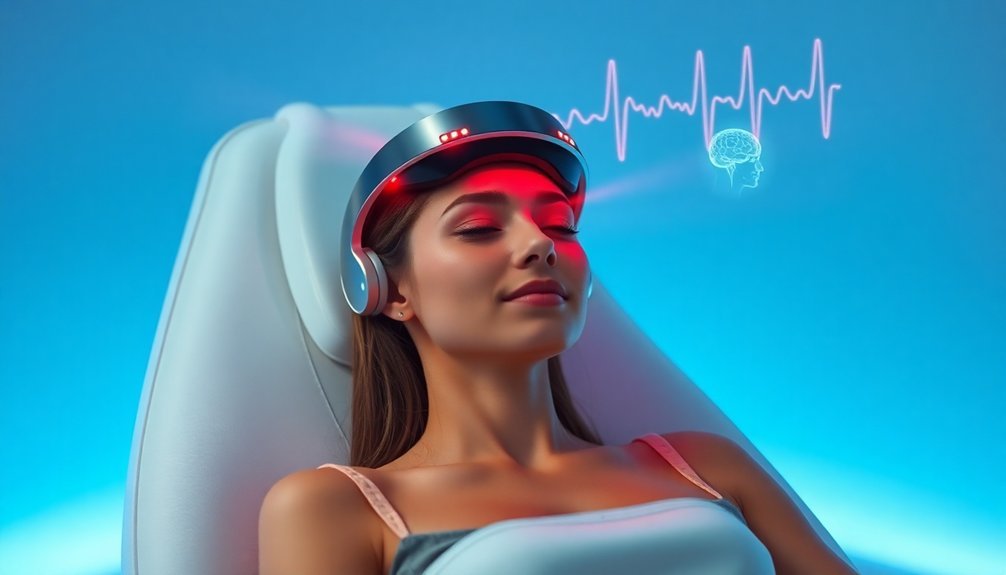
The future of light therapy is rapidly evolving with groundbreaking developments in both technology and applications. You'll soon see more personalized treatment options through smart devices that can analyze your specific needs and adjust light intensity and duration accordingly.
These innovations will connect to your smartphone, allowing you to track your progress and adjust treatments in real-time.
You can expect to see light therapy expanding beyond its traditional uses. Research is uncovering promising applications for neurological conditions, cognitive enhancement, and anti-aging treatments.
The integration of red light therapy with other treatment modalities, such as physical therapy and acupuncture, will offer you more thorough healing approaches.
Watch for revolutionary wearable devices that'll make light therapy more convenient and accessible. These devices will incorporate advanced LED panels and precise light delivery systems, ensuring you receive ideal exposure for maximum benefits.
The technology will become increasingly sophisticated, potentially offering genetic-based protocols tailored to your unique cellular response patterns.
You'll also find light therapy becoming more prevalent in various settings, from medical clinics to wellness centers, making it easier to incorporate this treatment into your regular healthcare routine.
Frequently Asked Questions
Can NIR Therapy Sessions Be Combined With Other Memory Enhancement Treatments?
You can combine NIR therapy with 40Hz light therapy, cognitive exercises, and certain medications. Just consult your healthcare provider first, as they'll help guarantee safe integration of multiple memory enhancement treatments.
How Much Does Professional NIR Brain Therapy Typically Cost per Session?
You'll typically pay between $15-$300 per NIR brain therapy session, with most clinics charging around $25 for a 20-minute treatment. Prices vary based on technology used and location. Package deals offer savings.
Are NIR Therapy Results Different for People With Genetic Predisposition to Dementia?
If you've got genetic predisposition to dementia, you'll likely still benefit from NIR therapy. Studies show it's effective in reducing amyloid beta aggregates and improving mitochondrial function, regardless of genetic factors.
Does Caffeine or Alcohol Consumption Affect NIR Therapy Effectiveness?
While caffeine at low doses may enhance your NIR therapy by improving brain oxygenation, you'll want to avoid alcohol since it could reduce effectiveness. The combined effects aren't well studied yet.
Can NIR Therapy Improve Memory in Young Adults Without Cognitive Issues?
Yes, you can benefit from NIR therapy even with normal cognitive function. Research shows it'll improve your short-term working memory by around 10%, enhancing your attention and focus as a young adult with healthy cognition.
In Summary
You've discovered an innovative way to enhance your memory through NIR brain therapy. With proven benefits for brain health, cognitive function, and potential dementia treatment, this non-invasive approach offers promising results. Whether you're seeking clinical sessions or exploring at-home options, NIR light therapy's documented success and safety profile make it worth considering. Keep watching this developing field as new research continues to reveal its full potential.
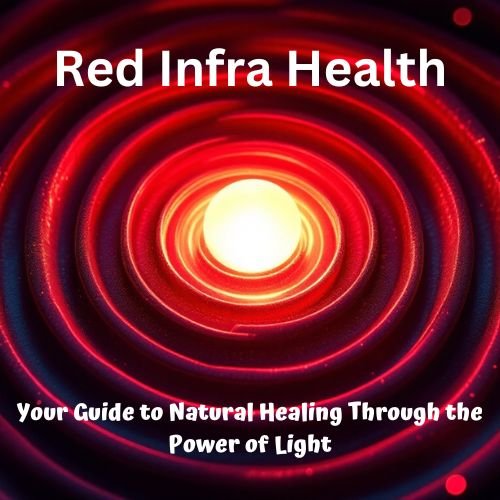
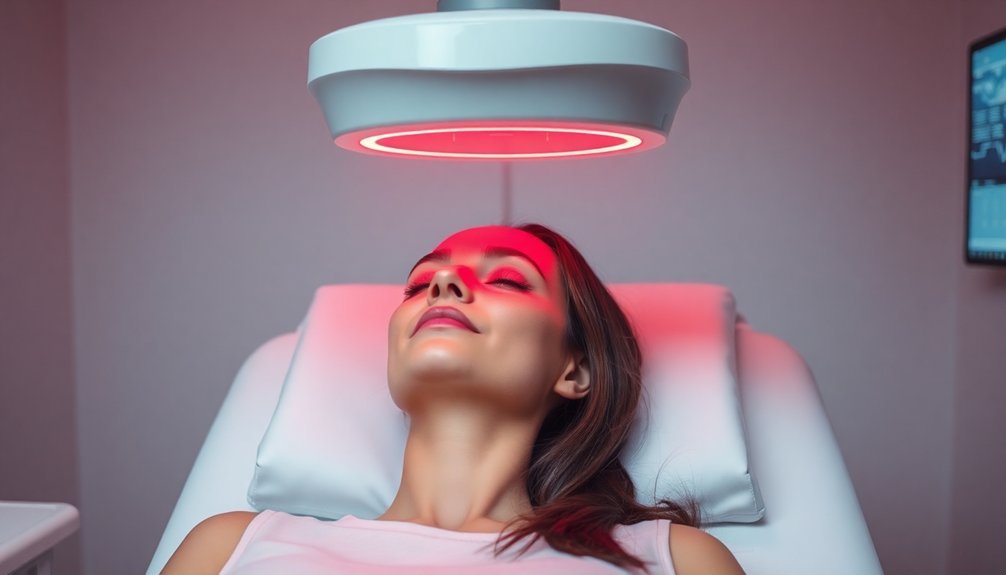



Leave a Reply